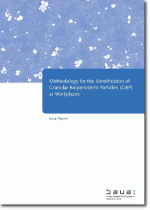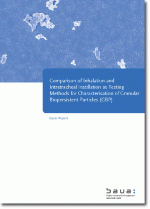Methodology for the Identification of Granular Biopersistent Particles (GBP) at Workplaces
The so-called GBP category was formed by definition, i.e. includes respirable Granular Biopersistent Particles without known significant specific toxicity. The category comprises various materials such as minerals, metals, metal oxides or polymers that show a negligible solubility in lung fluids (lung lining fluid, lysosomal fluid).
Module 1: In vivo study - Analysis of the bronchoalveolar lavage fluid (BALF) following intratracheal instillation
The analysis of the inflammatory potency of 6 GBP candidates included µ-TiO2 "Bayertitan T", nano-TiO2 P25, µ-Eu2O3, µ-BaSO4, µ-ZrO2 and nano-SiO2, each at a low (0.5 µl per rat) and high (1.5 µl) volumetric dose. In the differential cell count, µ-TiO2 did not induce statistically significant polymorphonuclear neutrophil (PMN) levels on day 3 post-treatment in the low dose group. The GBP requirement of a very low inflammogenicity was confirmed. PMN levels of approx. 12% in the high dose group indicated a bolus effect. µ-BaSO4 showed a behavior similar to µ-TiO2. In contrast, nano-TiO2 P25, µ-Eu2O3, µ-ZrO2 and nano-SiO2 did not meet this GBP criterion.
Module 1: In vivo study - Chemical analysis of the lung burdens
On day 3, an average retention of approx. 70% as compared to the administered total dose was detected; approx. 1/3 of the dose is eliminated from lungs by rapid clearance mechanisms (coughing, ciliae-mediated processes, etc). The clearance half-time showed a value close to the physiological rat lung clearance of approx. 60 days in the µ-TiO2 "Bayertitan T" low dose group. In the high dose group a doubled half-time was observed (overload effect). In the µ-BaSO4 and amorphous silica groups, smaller values in the range of 25-40 days were calculated indicating an additional dissolution effect. In the µ-Eu2O3 and µ-ZrO2 groups increased half-times, i.e. 4- to 5-fold and 2- to 4-fold, respectively, were calculated indicating a clear surface chemistry-related contribution to the toxic and clearance-retardative outcome.
At µ-TiO2 "Bayertitan T" and nano-TiO2 P25 very low ionic moieties regarding the total lung burden were detected (≤0.1weight-% in the 0.5 µl doses), the other dusts showed higher (0.2-0.7 weight-%) or very high (30 weight-%; Eu2O3) moieties.
Module 2: In vitro assays
The plasmid scission (PSA) and the cytotoxicity assay towards THP-1 cells indicated effects matching to the in vivo results in the Eu2O3 dust group. Overall, in vitro assays under investigation did not mirror the in vivo results with statistically significant power.
Module 3: Acellular solubility of test materials
On the basis of the acellular solubility results in artificial lung fluids a threshold value of ≤ 1 mg/l could be agreed on to define the category of "low soluble particles".
Outlook
The inhalation exposure pathway will show lower effects as compared to intratracheal instillation as no bolus effects will occur. Therefore, the final setting of maximum tolerable clearance t1/2 and PMN levels to define the GBP category should await the outcome of the inhalation validation study.
Bibliographic information
Title: Methodology for the Identification of Granular Biopersistent Particles (GBP) at Workplaces.
1. edition. Dortmund: Bundesanstalt für Arbeitsschutz und Arbeitsmedizin, 2017. pages: 102, Project number: F 2336, PDF file, DOI: 10.21934/baua:bericht20170419

